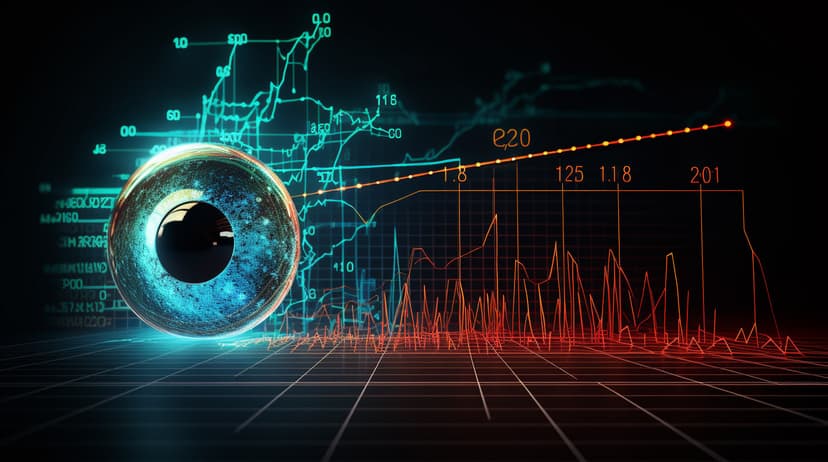
In the realm of ophthalmology, discerning the nuances of vision is an art as much as it is a science. The enigmatic grey zone, where clarity blurs and uncertainties arise, often holds the key to understanding the visual needs of individuals. Within this spectrum, two prevalent refractive errors take centre stage: myopia, or nearsightedness, and hyperopia, commonly known as farsightedness.
What Is The Grey Zone?
In the skilled hands of an ophthalmologist, the grey zone becomes a canvas, offering insights into the intricacies of one's visual acuity. By skillfully observing how the eye navigates this neutral landscape, professionals discern not only the need for corrective lenses but also unveil the potential for perfect vision.
The grey zone helps to show that perfect spectacle-free vision is a zone within which people don't need glasses.
If the focus of your eyes falls within the grey area you are spectacle free. As your focus falls further and further away from the grey zone your spectacle requirement increases.
For example: if someone's focus is -0.6 myopic and +0.4 astigmatism they are highly unlikely to need glasses to see.
If the focus is -1.2 myopic and -0.7 astigmatism they are very likely to want to wear glasses to see clearly.
Myopic Astigmatism
Myopic astigmatism is a common refractive error that affects vision. In this condition, the eye has two irregularly shaped surfaces, often likened to the shape of a rugby ball rather than a perfect sphere. This irregularity causes light rays to focus on multiple points in the eye, leading to blurred or distorted vision, both for objects at a distance and up close. Specifically, myopic astigmatism occurs when light entering the eye is focused in front of the retina rather than directly on it, resulting in difficulty seeing distant objects clearly. It is important to note that myopic astigmatism can often coexist with myopia (nearsightedness) and may require corrective measures such as glasses, contact lenses, or refractive surgery to achieve optimal vision. Consulting an eye care professional is crucial for an accurate diagnosis and appropriate treatment options tailored to an individual's specific visual needs.
Myopia Or Shortsightedness
Myopia, commonly known as nearsightedness, is a refractive error of the eye that affects a person's ability to see distant objects clearly. In this condition, the eyeball is longer than usual or the cornea (the clear front surface of the eye) is too curved. As a result, light entering the eye focuses in front of the retina instead of directly on it. This causes distant objects to appear blurry, while close-up objects can be seen clearly. People with myopia often find it challenging to read road signs, watch television, or recognize faces at a distance without the aid of glasses or contact lenses. It is a common vision condition, and while it can be hereditary, environmental factors such as extensive close-up work or prolonged screen time can contribute to its development. Myopia can be effectively corrected with corrective lenses, refractive surgery, or other vision correction methods prescribed by an eye care professional.
Hyperopia Or Longsightedness
Hyperopia, commonly referred to as farsightedness, is a refractive error of the eye that affects one's ability to see nearby objects clearly. Unlike myopia (nearsightedness), where the eyeball is elongated or the cornea is excessively curved, in hyperopia, the eyeball is often shorter than average. This leads to light focusing behind the retina instead of directly on it. As a result, individuals with hyperopia may experience difficulty with tasks that require close-up vision, such as reading or using a computer. While mild hyperopia may not be particularly bothersome, significant cases may cause eye strain, headaches, or blurry vision at any distance. Corrective lenses, such as glasses or contact lenses, can help bring close-up objects into focus for those with hyperopia. In some cases, refractive surgery may also be considered to adjust the shape of the cornea and improve vision.
Hyperopic Astigmatism
Hyperopic astigmatism is a refractive error that combines hyperopia (farsightedness) with astigmatism. In this condition, the eye has two irregularly shaped surfaces, causing light to focus on multiple points within the eye. This results in blurred or distorted vision, both for objects at a distance and up close. Specifically, hyperopic astigmatism occurs when light entering the eye is focused behind the retina instead of directly on it, causing difficulties in seeing both near and far objects clearly. It is important to note that hyperopic astigmatism can often coexist with other refractive errors, and it may necessitate corrective measures like glasses, contact lenses, or refractive surgery for optimal vision correction. Consulting an eye care professional is essential for a precise diagnosis and appropriate treatment options tailored to an individual's specific visual needs.
Vision Assessment Tests
In reality, vision assessment involves a series of specific tests and examinations conducted by an ophthalmologist or optometrist. These tests help determine if a person has refractive errors like myopia (nearsightedness) or hyperopia (farsightedness), or if they have perfect vision.
Here are some of the common tests used in vision assessment:
- Visual Acuity Test:
- This test measures the clarity or sharpness of vision. It's usually done using an eye chart with rows of letters or symbols of different sizes.
- Refraction Test:
- This test determines the exact prescription needed for corrective lenses. The patient looks through a phoropter, and the ophthalmologist or optometrist changes lenses to find the combination that provides the clearest vision.
- Retinoscopy:
- This is another test to determine the patient's prescription. The doctor shines a light into the eye and observes the reflection of the retina.
- Autorefractors and Aberrometers:
- These are computerised machines that provide an automated measurement of refractive errors.
- Slit-Lamp Examination:
- This instrument allows the doctor to examine the eye's structures, including the cornea, iris, and lens, under high magnification.
- Tonometry:
- This test measures intraocular pressure and is important in the evaluation of conditions like glaucoma.
- Pupil Dilation:
- The doctor may use special drops to dilate the pupils, allowing for a more thorough examination of the retina and optic nerve.
- Visual Field Test:
- This assesses the full horizontal and vertical range of what someone can see in their peripheral vision.
- Colour Vision Testing:
- This checks for any deficiencies in colour vision.
- Ophthalmoscopy or Funduscopy:
- This involves looking at the inside of the eye, particularly the retina, using a special instrument.
The specific tests performed may vary depending on the patient's age, medical history, and any specific vision concerns they may have. It's important to consult with an ophthalmologist or optometrist for a comprehensive eye examination and assessment.

What Treatments Are Best Suited To These Conditions?
Myopic astigmatism can be effectively managed with various treatment options, tailored to the severity of the condition and the individual's lifestyle preferences. Here are some of the most common treatments:
- Eyeglasses: Prescription eyeglasses are a straightforward and effective way to correct myopic astigmatism. Specially designed lenses account for both nearsightedness and astigmatism, providing clear vision.
- Contact Lenses: Soft or rigid gas permeable (RGP) contact lenses can correct myopic astigmatism. Toric contact lenses are specifically designed for astigmatism, ensuring a stable fit on the eye.
- Orthokeratology (Ortho-K): This non-surgical treatment involves wearing specially designed rigid contact lenses overnight to temporarily reshape the cornea. It can provide clear vision during the day without the need for glasses or contacts.
- Refractive Surgery: Procedures like LASIK (Laser-Assisted In Situ Keratomileusis) and PRK (Photorefractive Keratectomy) can permanently reshape the cornea, correcting myopic astigmatism. These surgeries are typically recommended for stable prescriptions and good candidacy.
- Implantable Collamer Lenses (ICLs): These are surgically implanted lenses that work with the eye's natural lens to correct refractive errors, including myopic astigmatism. They can provide clear vision without removing corneal tissue.
- Phakic Intraocular Lenses (PIOLs): Similar to ICLs, these are lenses inserted into the eye without removing the natural lens. They can correct a wide range of refractive errors, including myopic astigmatism.
- Conductive Keratoplasty (CK): This is a non-laser refractive surgery that uses radiofrequency energy to reshape the cornea, particularly useful for correcting astigmatism.
- Combination Treatments: In some cases, a combination of treatments may be recommended for optimal results, such as combining astigmatism-correcting contact lenses with LASIK surgery.
The best treatment for myopic astigmatism depends on factors like the severity of the condition, corneal thickness, age, overall eye health, and personal preferences. Consulting with an ophthalmologist or optometrist is essential to determine the most suitable treatment plan for an individual's specific needs and lifestyle.
The My-iClinic Journey
Discover a clearer world with My-iClinic! Whether you're dealing with Myopia, Hyperopia, or even Hyperopic Astigmatism, our expert team is dedicated to finding the perfect solution for your vision needs. Don't let refractive errors hold you back. Book your consultation today and take the first step towards a brighter, sharper future. Contact us now or visit our London Eye Clinic to explore your personalised vision correction options.
Find out more by Speaking to our team









